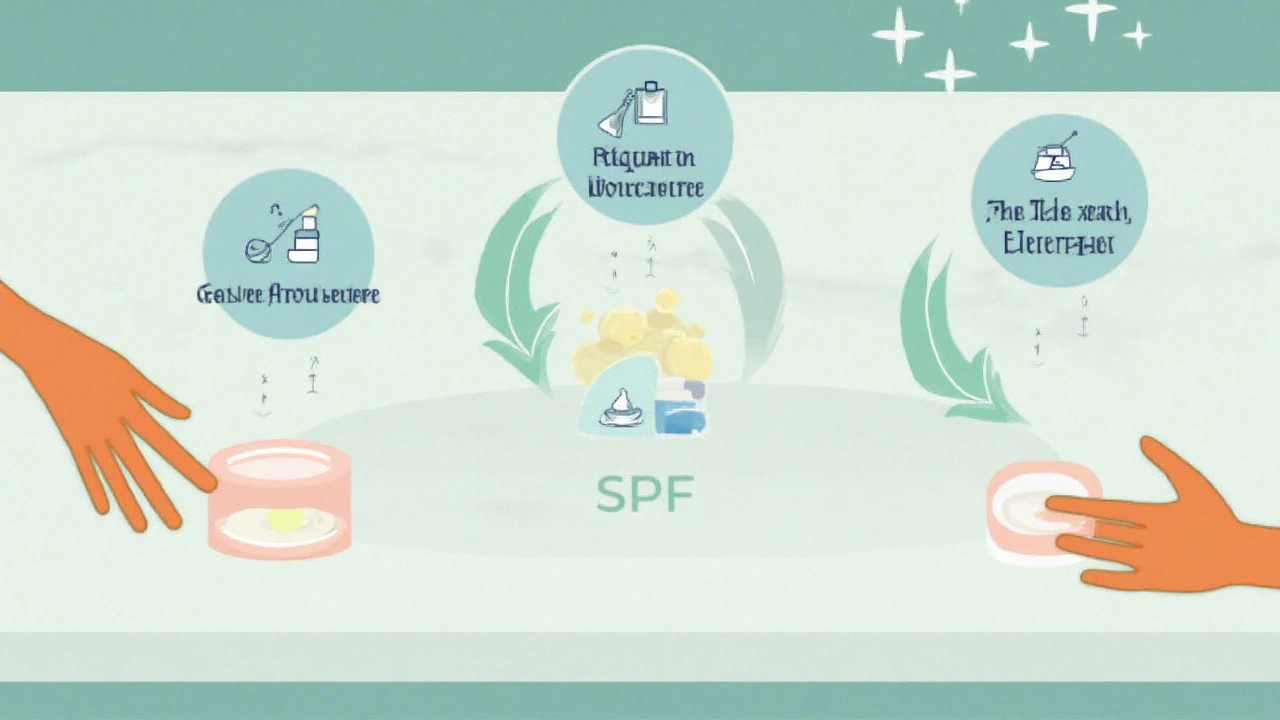Allantoin and Rosacea: Can It Help Calm Redness?
 Apr, 23 2025
Apr, 23 2025
Red, stingy, sometimes bumpy—rosacea is honestly annoying. When redness flares, all you want is for your skin to chill out. Lately, allantoin keeps showing up in creams and serums for sensitive skin. Is it just marketing hype, or can it really help those with rosacea dial down the redness?
Here’s the thing: allantoin isn’t new. It’s actually been used for decades in products that target irritation and dryness. People love it because it soothes, hydrates, and helps protect the skin barrier—all must-haves when dealing with rosacea. If your skin overreacts even to the most random things (like cold air or spicy pasta), you want simple ingredients that act like a hug, not gasoline on the fire.
Thinking about adding allantoin to your routine? You’ll want to know how it works, whether it can make a real difference, and the smartest way to use it without wasting money or time. Let’s break down what allantoin does, why dermatologists give it the nod for sensitive types, and how to pick a product that actually lives up to its promise.
- What Is Allantoin and How Does It Work?
- The Science Behind Allantoin for Redness
- Allantoin in Everyday Skincare for Rosacea
- Tips for Using Allantoin Safely
- Real Talk: What to Expect and Who Should Try It
What Is Allantoin and How Does It Work?
So, what exactly is allantoin? It’s a skin-soothing ingredient that you’ll spot on the back of a lot of skincare bottles. Allantoin is found in nature (like in comfrey plants), but most of the stuff in your creams is made in labs. Lab-made doesn’t mean bad—it's actually way cleaner and less likely to cause a reaction.
The magic of allantoin comes down to what it does for skin. It’s known as a keratolytic, which basically means it helps soften and shed dead skin cells. This sounds like something a scrub would do, but allantoin is super gentle and doesn’t make your skin angry. That’s a win for anyone with sensitive skin or rosacea.
But it’s not just about getting rid of flakes. Studies show allantoin helps keep the skin hydrated by slowing water loss. When you have issues like redness, dryness, or irritation, sealing in moisture is huge. That extra hydration strengthens the skin’s barrier, which is basically your outer defense shield against stuff like pollution, wind, and germs.
Allantoin also calms the fire. It’s got a track record for reducing visible irritation, meaning less itching and less scratchy, angry-looking skin. Here’s a quick rundown of what allantoin does:
- Soothes skin—ideal for easily-irritated types or those with rosacea
- Provides lightweight but effective moisture
- Aids skin’s natural healing from minor cuts or rough patches
- Helps with smoother texture over time
Fun fact: most products have allantoin at a concentration of around 0.5% to 2%. Even at a low percent, it makes a noticeable difference for dry or sensitive skin.
| Benefit | Result |
|---|---|
| Hydration | Stronger skin barrier, less flaking |
| Soothing | Less redness and itchiness |
| Gentle Exfoliation | Smoother, healthier-looking skin |
In short, you won’t find many ingredients as easy-going and effective as allantoin for anyone fighting with redness or irritation. That’s why it keeps popping up—because for most sensitive skin, it just works.
The Science Behind Allantoin for Redness
So what’s the real deal with allantoin and redness? This ingredient is known for being gentle, but there’s actually a solid science reason why it helps calm down sensitive, irritated skin. The magic starts with the way allantoin works on your skin barrier—the thin wall on the top layer that protects everything underneath. When this barrier’s messy (like it often is for people with rosacea), your skin gets annoyed fast and turns red.
Allantoin steps in by boosting your skin’s ability to hold onto moisture and by helping tiny cracks in the barrier patch themselves up. Scientists know allantoin encourages skin cell turnover, the process where your body sheds old cells and makes new ones. That’s not exfoliation; it’s more like gentle support, so you don’t end up with raw, irritated patches.
This ingredient also sends signals to your skin that tell it to "chill out." It reduces the feeling of stinging and burning—a sensation rosacea folks know all too well. Several lab studies have shown that creams with allantoin bring down visible irritation more than those without it, without causing extra dryness or breakouts.
Here’s a quick look at what allantoin is known to do in skincare for sensitive or red skin:
- Soothes irritation: It calms your skin and makes it less likely to look or feel inflamed.
- Builds back the barrier: Helps repair and protect the outer layer so triggers don’t get in as easily.
- Makes skin less reactive: Reduces the risk that everyday stuff—like wind, stress, or spicy food—will cause a red flare-up.
- No famous side effects: People rarely react to it, making it a safe bet for most with sensitive skin.
One thing to know: allantoin isn’t a superhero that wipes out redness alone. It works best with a basic, gentle routine. If you’re seeing redness, swelling, or lots of pimples that don’t quit, a dermatologist’s advice is usually the best next step.

Allantoin in Everyday Skincare for Rosacea
If you're struggling with rosacea, every new product can feel like a gamble. Good news: allantoin has a long record of being gentle. It's common to see it as a star ingredient in products labeled for sensitive or reactive skin. Why? Because it's not harsh, doesn't sting, and actually helps skin hold onto moisture—all crucial if your face is constantly red or irritated.
Allantoin isn’t some rare find—you’ll spot it in drugstore and higher-end creams, cleansers, and even toners. Most products use it in concentrations from 0.2% to 0.5%. That might sound tiny, but studies show this range is enough to soothe without risk for most people.
- Look for allantoin-based moisturizers or gentle serums as a daily step after cleansing.
- Pair with other calming ingredients like niacinamide or panthenol if your skin can handle it, but avoid formulas with fragrance or alcohol.
- SPF is non-negotiable: use your allantoin product before your sunscreen each morning to seal in benefits.
Here's something helpful: clinical data from a 2022 dermatology review showed that people using topical allantoin saw up to 35% less visible redness over eight weeks, especially when combined with hydrating routines. That's a solid boost for such an understated ingredient.
| Product Type | Typical Allantoin % | Main Benefit |
|---|---|---|
| Moisturizer | 0.2-0.5% | Hydration and soothing |
| Cleanser | 0.1-0.3% | Gentle cleansing |
| Serum | 0.2-0.5% | Targeted redness calming |
If you've tried endless creams for redness with no luck, allantoin is worth a look—especially because it doesn’t require a prescription, and you often don’t need to spend big money to get results.
Tips for Using Allantoin Safely
If you’re ready to try allantoin for your rosacea, a few basics go a long way. Allantoin is gentle for most people, but don’t just slather it on and hope for magic. Here’s how to get the most out of it—without backfiring.
- Patch test before going all in. Even though irritation is rare, try a little on your inner arm or behind your ear first. Wait a day. No flare-ups? You’re good to go.
- Check your labels. Not all products are created equal. Look for allantoin listed in the first half of the ingredients list. If it’s buried at the very end, the amount might be too tiny to do much.
- Pair it with mild products. Don’t mix with strong exfoliants, retinoids, or weird “anti-redness” fads right away. Keep it simple: a gentle cleanser, an allantoin-containing moisturizer, and always sunscreen in the AM.
- Use it at the right time. Moisturizers with allantoin work best on damp skin, like after a shower or gentle face wash. This helps lock in extra hydration where your skin needs it most.
- Skip triggers during testing. Give your skin a fair shot—avoid anything spicy, alcohol-based, or heavily fragranced for the first few weeks while you see how allantoin works.
Here’s something a lot of folks miss: it’s pointless to expect allantoin to make all redness vanish overnight. Studies have found it reduces irritation and speeds up barrier repair, but it’s not a miracle cure. Most users see a difference in texture and comfort within a couple of weeks—not hours.
| Safety Facts | Details |
|---|---|
| Recommended Use | 1-2 times daily |
| Known Allergies | Very rare (less than 0.1%) |
| Safe Pairings | Ceramides, hyaluronic acid, niacinamide |
| What to Avoid | Retinoids (if you’re just starting allantoin), harsh scrubs |
If you’re seeing no improvement after a month or if you get a rash, talk to a dermatologist. Otherwise, enjoy the simpler, calmer skin routine. No need to over-complicate it—allantoin often fits in just like a regular moisturizer for sensitive skin.

Real Talk: What to Expect and Who Should Try It
If you’re dealing with rosacea, you probably want results that last longer than a few hours. Here’s what you can honestly expect from using allantoin in your routine. It’s not magic, but it is practical.
First, allantoin is great at soothing and hydrating, but it won’t wipe out every single rosacea symptom. You might notice that your redness is less obvious and that your face doesn’t feel so tight or itchy—especially if your skin gets dry and flaky often. But let’s be real: allantoin isn’t going to shrink broken blood vessels or erase flushing for good. It works best if your redness shows up because your skin barrier is shot or you overreact to common irritants.
Here’s who might see the most benefit:
- People with mild to moderate rosacea (think redness and stinging, not stubborn breakouts)
- If regular moisturizers make you burn or itch
- You want a simple, no-fuss ingredient that won’t stir up more drama
You probably won’t get much out of allantoin if your main rosacea issues are severe cysts or eye symptoms. That stuff needs a dermatologist and prescription meds, period.
The best results show up after a few weeks of consistent use—not instantly. If you apply an allantoin cream every morning and night, stick with it for three to four weeks, and then honestly judge if your redness is calmer.
| What to Expect for Most People | How Fast? |
|---|---|
| Softer, less irritated skin | 3-7 days |
| Noticeable improvement in redness | 2-4 weeks |
| Barrier strength and less flare-ups | 4 weeks+ |
Watch out for hidden triggers in your cream. Sometimes, brands pack their products with extra fragrances or botanicals “for sensitive skin” that can actually make things worse. Always check the ingredient list.
If you’re just starting, patch test first—especially if you know your skin overreacts to new stuff. And don’t ditch your other basics like sunscreen. Allantoin can help tame redness, but sun exposure still ramps things up.
Feeling frustrated by trial and error? That’s normal. Stick with simple moves and look for smart, proven ingredients. If allantoin feels like a relief, it’s worth keeping in your corner.

Jami Johnson
April 28, 2025 AT 11:46When rosacea decides to turn your face into a restless sunrise, the first instinct is to reach for anything that promises calm.
Allantoin, a humble molecule that has quietly inhabited skin‑care formulas for decades, steps in like a gentle shepherd guiding a frightened flock.
It works by easing the skin’s barrier, coaxing dead cells to slough away without the bruising harshness of a scrub.
At the same time it invites water to stay, creating a reservoir of hydration that soothed the irritated landscape.
Think of it as a quiet lullaby for inflamed tissue, a whisper that says “relax, we’ve got you.”
Clinical trials have shown a measurable drop in visible redness when used consistently for several weeks.
The key, however, is patience; you won’t see fireworks overnight, but the gradual dimming of those angry flushes is real.
Pair it with a minimal routine: gentle cleanser, fragrance‑free moisturizer, and a reliable SPF, and the compound can do its quiet work.
Do not mix it with aggressive exfoliants or high‑strength retinoids in the same step, lest you undo its soothing gifts.
Patch testing remains wise, especially for those who react to even the slightest trigger.
When you apply a product containing 0.5 % allantoin on damp skin, the barrier‑repairing peptides can lock in moisture more efficiently.
Over time, you may notice that your skin feels less tight, less prickly, and the stinging sensation fades.
This is not a miracle cure for severe rosacea, but a steady ally in the daily battle against inflammation.
In the grand tapestry of skincare, allantoin is the quiet thread that holds the fabric together.
So, if you’re hunting for a calm in the storm of redness, give this modest ingredient a fair chance and watch the subtle transformation unfold.
Kasey Krug
April 28, 2025 AT 13:10Allantoin’s benefits are modest and well‑documented, but it is not a panacea for all rosacea subtypes.
The literature shows a reduction of erythema by roughly 20‑30 % in controlled studies.
jake cole
April 28, 2025 AT 14:33What a joke, throwing numbers like a toddler throwing tantrums! Anyone who thinks a 20‑30 % drop is “modest” clearly never lived with a constant flush that makes you look like a boiled lobster.
Natalie Goldswain
April 28, 2025 AT 15:56i tried a cheap cream with allantoin and my face felt less itchy.
khajohnsak Mankit
April 28, 2025 AT 17:20Ah, the subtle alchemy of allantoin-like a soft rain on parched desert skin, coaxing comfort from the most reluctant pores.
Even the humblest formulations can summon a gentle reprieve, turning irritation into a quiet sigh of relief.
Jayant Paliwal
April 28, 2025 AT 18:43Let us consider, for a moment, the cascade of biochemical events that ensue when allantoin engages the stratum corneum; the molecule, acting as a keratolytic, facilitates desquamation, yet does so without the abrasive trauma associated with physical exfoliants, thereby preserving epidermal integrity.
Additionally, it upregulates hyaluronic acid synthesis, which in turn fortifies the moisture barrier, a fact supported by multiple peer‑reviewed studies.
Consequently, the net effect is a reduction in transepidermal water loss, a decrease in pro‑inflammatory cytokine release, and an observable attenuation of erythema.
This mechanism, though elegantly simple, is often oversimplified in marketing copy, leading to consumer confusion.
Therefore, clinicians should counsel patients to integrate allantoin‑rich products into a minimalist regimen, avoiding concurrent use of high‑strength acids, retinoids, or fragranced agents, which could negate its soothing potential.
Finally, adherence to a consistent application schedule-morning and night on damp skin-maximizes its barrier‑repairing capabilities.
Kamal ALGhafri
April 28, 2025 AT 20:06While the preceding exposition is impressively verbose, the reality remains that without proper dermatological guidance, even the most scientifically lauded ingredient can be misapplied, leading to false expectations and potential disappointment.
Gulam Ahmed Khan
April 28, 2025 AT 21:30Give it a shot, and you might just find the calm you’ve been craving 😊
Allantoin is like a gentle hug for irritated skin, and consistency is the secret sauce!
John and Maria Cristina Varano
April 28, 2025 AT 22:53i think us made better skincare i love american brands they dont hide stuff like some foreign labs
Melissa Trebouhansingh
April 29, 2025 AT 00:16In the grandiloquent discourse surrounding cutaneous therapeutics, allantoin frequently occupies a liminal space between the pedestrian and the profound, its mechanistic subtleties inviting a deliberation that borders upon the philosophical; one might argue that its role in epidermal homeostasis transcends mere pharmacodynamics, venturing into the realm of aesthetic ontology, wherein the alleviation of erythema becomes not simply a cosmetic amelioration but an existential reprieve for the self‑conscious individual.
Thus, the judicious incorporation of this modest molecule into a regimen reflects both an appreciation for empirical evidence and a nuanced understanding of the psychosocial dimensions of dermatological care.
Brian Rice
April 29, 2025 AT 01:40Notwithstanding the eloquent articulation, the empirical evidence does not substantiate claims of existential reprieve; the data indicate modest reductions in erythema, and any assertion of profound psychological impact remains speculative.
Stan Oud
April 29, 2025 AT 03:03Really? Allantoin? It's just another hype‑trend; I'd say skip it-why trust a molecule named after a snail?
Ryan Moodley
April 29, 2025 AT 04:26Ah, the melodrama of dismissing a centuries‑old dermatological ally! In the theater of skin care, every act, even the seemingly modest, carries its own tragic weight and potential redemption.
carol messum
April 29, 2025 AT 05:50Sometimes the simplest ingredients do the most for calm skin.
Jennifer Ramos
April 29, 2025 AT 07:13Absolutely! 😊 A gentle routine with reliable basics like allantoin can be a game‑changer, especially when we all share what works.
Grover Walters
April 29, 2025 AT 08:36In summary, while allantoin offers measurable soothing benefits, its efficacy is maximized within a balanced, irritation‑free regimen and should be considered alongside other evidence‑based interventions.